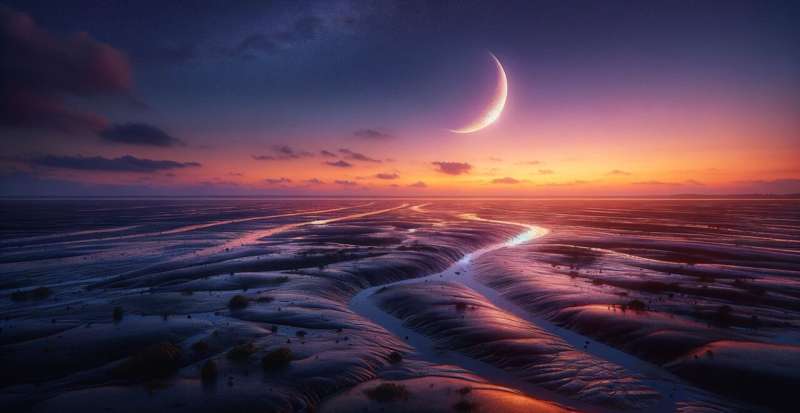Ancient Eukaryote Fossils Display Remarkable Diversity and Complexity

On January 11, 2024, this scientific article was subjected to the rigorous editorial process and policies of Science X. Editors have assured the text of these key qualities for credible content:
- fact-checked
- peer-review publication
- trusted source
- proofread
by Harrison Tasoff, University of California - Santa Barbara
Sunset falls over a tranquil mudflat in Australia's Northern Territory, where life is scarcely visible but for some slime in numerous ponds. Within it is housed a diverse microbial community tracing back our primeval forebears.
Researchers from UC Santa Barbara and McGill University document a newly found display of impressively conserved microfossils, showing that eukaryotic entities had already diversified substantially 1.64 billion years ago. Their study, available in the journal Papers in Paleontology, narrates a collection of eukaryotic fossils from an early period in the evolution of the group. They note four new taxonomic classifications and proof of a variety of complex traits already existing in these primitive eukaryotes.
'These are among the most ancient eukaryotes found to date,' states lead author and assistant researcher at UCSB's Department of Earth Science Leigh Anne Riedman. 'Yet, we see a remarkable expanse of variety even in these initial records.'
Eukarya, one of the chief domains of life, includes the plant, animal and fungi clades, along with all other groupings having a membrane-bound nucleus, such as protists and seaweeds. Earlier beliefs suggested that initial eukaryotes during the late Paleoproterozoic were quite similar and diversified around 800 million years ago. However, Riedman's study discloses fossils displaying a surprising variety of complex entities in considerably older rocks.
Earlier studies had shown that eukaryotes evolved during this era, although their diversity was poorly understood. Riedman journeyed to the outback in late 2019 and in one week she collected around 430 samples from eight cores drilled by a prospecting company. These samples now exist in the Northern Territory Geological Survey's library. From the drilled cores for this research, a time span of approximately 133 million years was covered, with significant deposition around 15 million years.
Returning to the United States, Riedman brought back shale and mudstone - traces of an ancient, fluctuating coastal ecosystem that oscillated between shallow, subtidal mudflats and coastal lagoons. Upon dipping these in hydrofluoric acid, the matrix rock was dissolved, leaving behind the invaluable microfossils for examination under a microscope.
Riedman aimed to discover species with unique and varying characteristics in their cell walls. These features might provide insights into the happenings inside cells during this time. Drawing any conclusions about the cell's interior required some forensic investigation since only exterior details were preserved in the fossils.
Acquiring 26 taxa, including 10 species not documented before, the researchers were taken aback by the complexity and variation in theses fossils. They found indirect evidence of cytoskeletons and structures suggesting the existence of internal vesicles, possibly a precursor to Golgi bodies in contemporary eukaryotic cells. Other microbes displayed cell walls constructed from bound fibers, suggestive of a complex cytoskeleton.
Various cells with a miniature trap door, a sign of complexity, were also discovered. Some microbes can form a cyst to endure unfavorable environmental conditions. To exit, they need to create an opening in their protective shell - a specialized task.
'Executing such a process that disintegrates their protective cell wall requires a careful enzyme application,' states Riedman. 'So, we are seeing significant complexity levels even in the earliest records of eukaryotes.'
Many professionals thought such an ability evolved later, emphasizing how advanced and varied eukaryotes were, even early on. According to co-author Susannah Porter, an Earth Science Professor at UC Santa Barbara, 'The presumption was that this was approximately the time that eukaryotes appeared. And now we think that people simply haven't investigated older rocks.'
This paper is part of a larger project investigating early eukaryote evolution. Riedman and Porter want to know in what environments early eukaryotes were diversifying, why they were there, when they migrated to other places, and what adaptations they needed in order to fill those new niches.
A big part of this effort involves understanding when different characteristics of eukaryotes first arose. For instance, the authors are quite interested to learn whether these organisms were adapted to oxygenated or anoxic environments. The former would suggest that they had an aerobic metabolism, and possibly mitochondria. Every modern eukaryote that's been found descends from ancestors that possessed mitochondria. This suggests that eukaryotes acquired the organelle very early on, and that it provided a significant advantage.
Riedman and Porter are currently working on a fresh account of eukaryote diversity through time. They've also collected even older samples from Western Australia and Minnesota. Meanwhile, their geochemist collaborators at McGill are spearheading a study on oxygen levels and preferred eukaryote habitats, aspects that could shed light on their evolution.
'These results are a directive to go look for older material, older eukaryotes, because this is clearly not the beginning of eukaryotes on Earth,' Riedman said.
Journal information: Papers in Palaeontology
Provided by University of California - Santa Barbara




